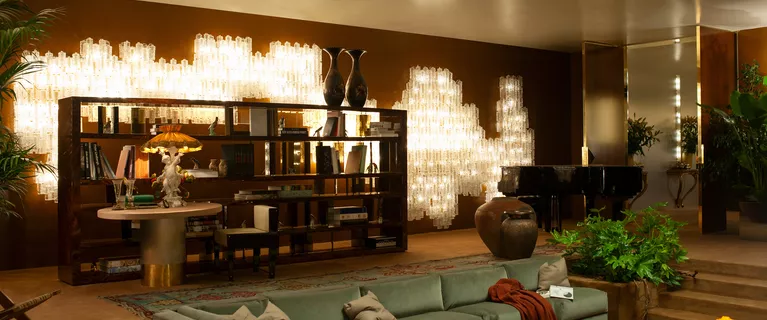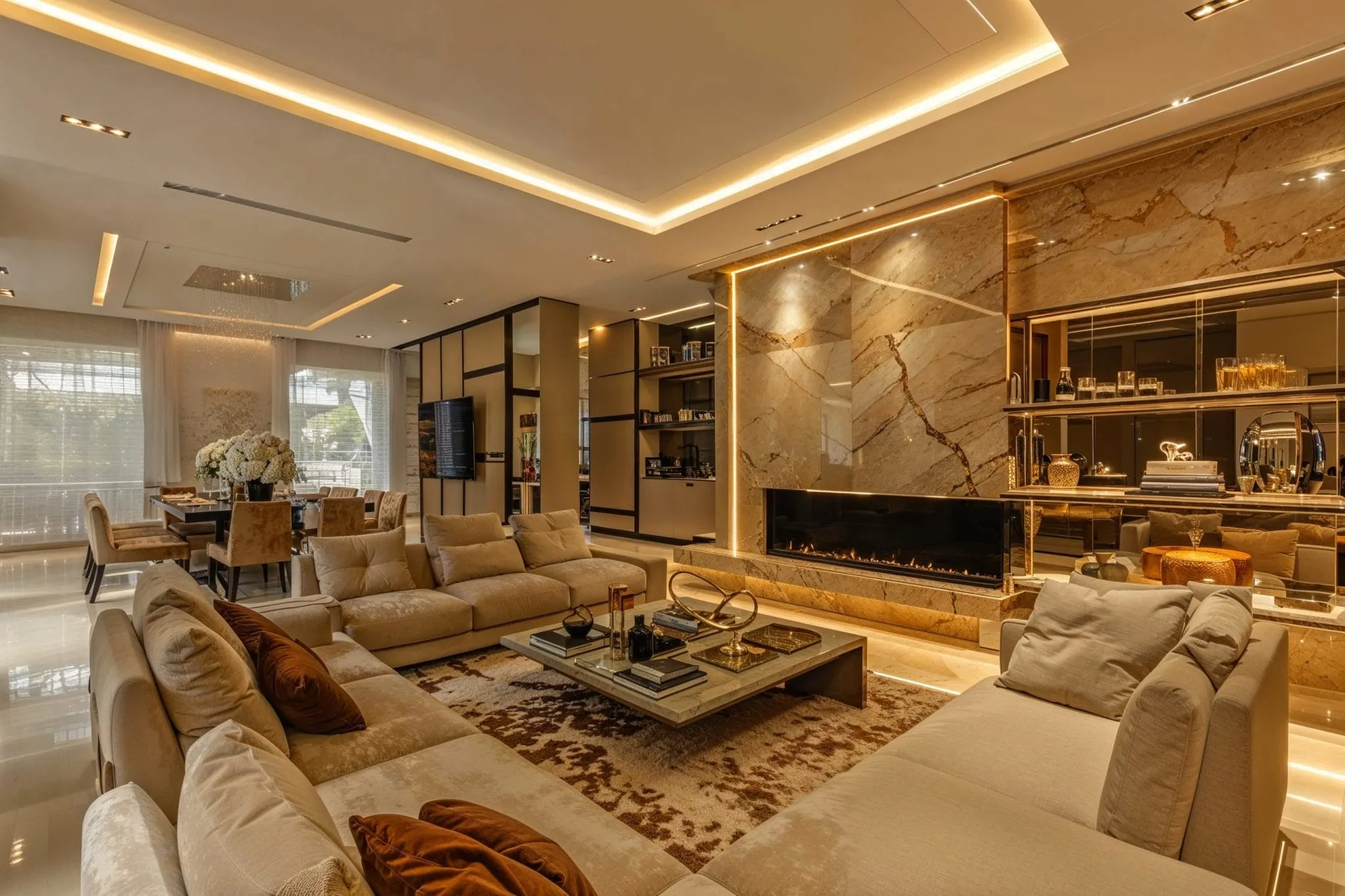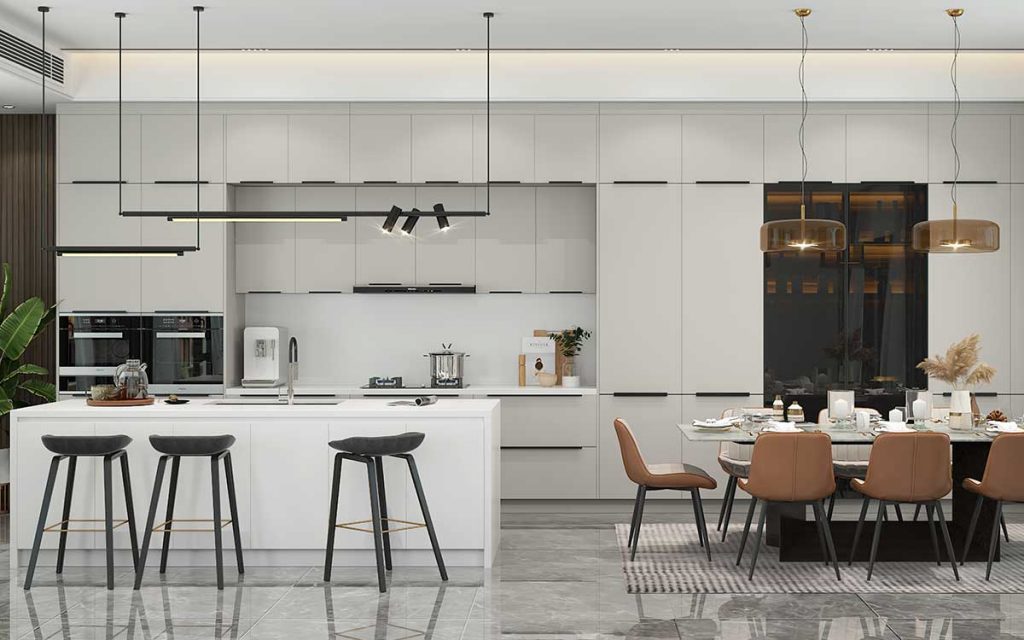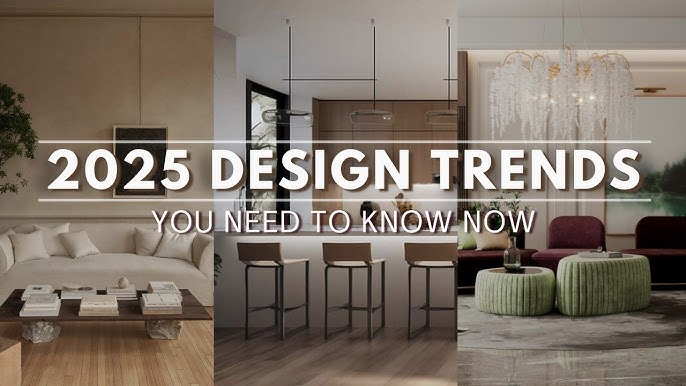Foundations of Modern Home Design in 2025
Introduction: The Evolution of Home Design
Home design is more than just about beauty—it’s a dynamic expression of how we live. As we approach 2025, the very fabric of home interiors is evolving. With a growing emphasis on sustainability, technological integration, and versatile functionality, modern homes must be adaptable, energy-efficient, and a reflection of the lifestyles we lead.
As we shift into this new era of design, it’s essential to not only focus on aesthetics but to make thoughtful choices that improve the overall quality of life. Homes in 2025 need to be livable, flexible, and sustainable, prioritizing comfort and convenience while integrating the latest in design trends.
The core principle for 2025 is blending style with purpose. A well-designed space doesn’t just look good—it works for you. Here’s how we can make that happen, starting from the basics.
Sustainability: The New Standard
Sustainability is no longer a niche concept—it’s the new standard. With climate change, rising utility costs, and a growing awareness of environmental issues, homeowners are increasingly making eco-conscious decisions. Sustainable design isn’t just about using recycled materials—it’s a holistic approach to how we build, live in, and maintain our homes.
In 2025, sustainability has become deeply integrated into the home design process. From energy-efficient appliances to solar panels and water-saving fixtures, green design isn’t just about looking good—it’s about creating a home that’s built for the future. The key here is considering the entire lifecycle of the materials you choose, from sourcing to installation to disposal.

Key Home and Decor Trends for 2025
Key Sustainable Features in 2025 Homes:
-
Energy-efficient Appliances: The demand for smart appliances that consume less energy is rising. Innovations in dishwashers, refrigerators, and HVAC systems ensure that homeowners can reduce their energy consumption without sacrificing convenience.
-
Solar Power Integration: More homes are outfitted with solar panels, enabling homeowners to harness the sun’s power. Whether as a primary energy source or a supplement to traditional utilities, solar power can significantly reduce energy bills while decreasing your carbon footprint.
-
Eco-friendly Materials: Materials like bamboo, cork, and recycled metals are gaining traction in flooring, cabinetry, and furniture. These materials not only look beautiful but also contribute to a more sustainable home.
When designing or renovating a home, think about materials and technology that will both minimize the environmental impact and maximize long-term savings. A home built with sustainability in mind can contribute to a healthier planet and a more comfortable living space for you and your family.
Smart Homes: Technology-Driven Living
Smart homes are no longer a futuristic concept—they’re a present-day reality. In 2025, integrating technology into home design isn’t a luxury; it’s a necessity. Homes are becoming more intuitive, with devices that learn from your habits and automate day-to-day tasks.
From security systems that alert you to intruders to smart lighting that adjusts to your mood, technology is seamlessly blending into the home environment. Smart homes not only provide convenience but also increase safety and energy efficiency. With innovations like smart thermostats that learn your heating preferences or refrigerators that track food inventory, these devices are making daily life easier and more efficient.
Examples of Smart Home Features:
-
Voice-Controlled Devices: From controlling the lights to adjusting the thermostat, voice assistants are making it easier than ever to control various aspects of your home without lifting a finger.
-
Smart Security Systems: Integrated security cameras, doorbell cameras, and motion sensors keep your home safe and secure. These systems can be monitored remotely and even send alerts to your phone if any unusual activity is detected.
-
Energy Management Systems: Smart thermostats like Nest and Ecobee not only learn your preferences but also help you save energy by adjusting the temperature when you’re away.
Integrating these technologies into your home can create a more efficient and comfortable living environment. The result is a home that’s both functional and futuristic, offering a level of convenience and security that was once unimaginable.
Maximizing Small Spaces
As urbanization continues to rise, more and more people are finding themselves living in smaller homes. Whether you’re in a downtown apartment or a compact suburban home, maximizing space is a priority. But small spaces don’t have to feel cramped. With thoughtful design, you can transform any room into a spacious, functional oasis.
In 2025, designers are increasingly utilizing innovative solutions that combine form and function. Multifunctional furniture is one of the biggest trends in small-space living. From fold-out desks to modular sofas, these pieces are not only space-savers but also stylish additions to your decor.
Space-Saving Design Ideas:
-
Multifunctional Furniture: Invest in furniture that can serve multiple purposes. A sofa that doubles as a guest bed, or a dining table that can be folded down, can make a small space feel expansive.
-
Built-in Storage: Built-in shelving, under-bed storage, and wall-mounted units help keep clutter to a minimum while adding a modern, minimalist vibe to your space.
-
Vertical Storage: Think upward rather than outward. Wall-mounted shelves and hanging storage allow you to utilize every inch of your space.
The key to designing a small space is keeping it clutter-free while selecting pieces that offer both style and function. Minimalist furniture and clean lines are a perfect match for smaller spaces, making them feel open and airy.

Living-room-design-ideas-2025-highlighting-modular-furniture-and-layered-lighting
Creating Cozy and Inviting Spaces
While minimalism is trending, there’s also a growing movement toward creating cozy, inviting homes that feel lived in and warm. The key here is to combine modern design with comfort. In 2025, homes should feel like a sanctuary—places where people can unwind and relax.
One of the easiest ways to create a cozy atmosphere is through the use of textiles. Soft throw pillows, plush blankets, and area rugs can instantly add warmth and texture to a room. Layering different textures—wood, fabric, and metal—can also create a sense of depth, making your space feel more dynamic and inviting.
Ideas for Adding Comfort to Your Home:
-
Textural Contrast: Mix different textures to create a rich, layered look. Combine soft fabrics like velvet with rugged materials like wood or metal.
-
Lighting: Use soft, warm lighting to create a relaxed atmosphere. Consider adding dimmable lights or smart bulbs that allow you to adjust the brightness based on the time of day.
-
Personal Touches: Incorporate personal items like family photos, heirlooms, or hand-crafted objects to make your space feel truly yours.
The goal is to create a balance between sleek, modern design and the warmth that makes a home feel comfortable and welcoming.
Conclusion: Setting the Stage for 2025 Home Design
In conclusion, home design in 2025 is about embracing both form and function. It’s about making your space work for you while creating a place that feels like home. Sustainable practices, smart technology, and space-saving designs are all essential components of modern home design. But equally important is the ability to create a space that reflects your personal style, values, and needs.
As we move toward 2025, keep in mind that the home should not only be aesthetically pleasing but also functional, efficient, and sustainable. The foundation of your home design starts here—with a focus on longevity, quality, and comfort. This is just the beginning of your journey toward creating a home that is truly your own.

Living-room-design-ideas-2025-highlighting-modular-furniture-and-layered-lighting
Advanced Design Principles and Current Trends in 2025
The Rise of Biophilic Design
In 2025, one of the most significant trends in home design is biophilic design, which seeks to reconnect individuals with nature. The biophilic design principle integrates natural elements into the built environment, making homes feel more open, airy, and refreshing.
The idea behind biophilic design is that exposure to nature has a direct impact on our well-being, improving mood, reducing stress, and even increasing productivity. Incorporating natural elements like plants, wood, stone, and natural light can dramatically transform the way you feel in your home.
Key Elements of Biophilic Design:
-
Indoor Plants: Including plants in every room of your home can improve air quality and add a touch of greenery to otherwise sterile spaces.
-
Natural Materials: Materials like wood, stone, and bamboo are increasingly being used for furniture, flooring, and finishes. These elements add warmth and texture while creating a grounded atmosphere.
-
Natural Light: Maximizing natural light is a core aspect of biophilic design. Large windows, skylights, and open spaces allow sunlight to pour in, making rooms feel more vibrant and inviting.
-
Water Features: Indoor fountains, aquariums, or even water-based art installations are becoming popular. The soothing sound of water adds a calming effect to the environment.
By infusing nature into interior design, you’re not only enhancing the aesthetic appeal but also creating a healthier, more calming environment for all who inhabit the space.
Minimalism: The Enduring Trend
Minimalism continues to be a dominant design trend as we move into 2025. The minimalist style is about more than just clearing clutter—it’s about creating functional, visually balanced spaces that emphasize simplicity and elegance.
Minimalist homes prioritize open spaces, clean lines, and a neutral color palette. Every piece of furniture or decor has a purpose, eliminating unnecessary adornments that don’t serve a function. This approach emphasizes quality over quantity, focusing on timeless pieces that will last for years.
Principles of Minimalism in Home Design:
-
Open Floor Plans: A minimalist approach often involves removing walls to create open, flowing spaces. This design principle encourages a sense of freedom and lightness in a home.
-
Neutral Color Palettes: White, gray, beige, and black are the staple colors in minimalist design. These neutral tones help make a space feel calm and serene, allowing the architecture and furniture to stand out.
-
Functional Furniture: Furniture in minimalist spaces is often sleek and simple, with storage solutions that maintain a tidy appearance. Think of clean lines, hidden compartments, and multi-purpose items.
-
Quality over Quantity: Instead of filling the space with too many pieces, focus on high-quality, impactful items that enhance the overall aesthetic without overwhelming it.
By embracing minimalism, your home becomes a sanctuary of tranquility, where every element has its place and purpose. This timeless style remains a top choice in 2025 for homeowners looking to simplify their living spaces.
Designing for Flexibility: Adaptable Spaces
The modern home needs to be flexible and adaptable to the changing needs of its inhabitants. With the rise of remote work, multi-generational living, and the shift toward sustainability, the need for flexible spaces has never been more evident.
Homeowners are increasingly looking for multifunctional spaces that can adapt to different activities. An office can transform into a guest room, a dining area can become an entertainment zone, and a living room can easily accommodate both family time and individual relaxation.
Ways to Design Flexible Spaces:
-
Multi-Purpose Furniture: Think of foldable desks, Murphy beds, or modular seating that can be reconfigured based on your needs. The goal is to have a flexible layout that can evolve over time.
-
Room Dividers: Sliding doors, curtains, or folding screens allow you to create distinct areas within an open-plan space. These dividers help create privacy when needed without sacrificing openness.
-
Mobile Storage: Invest in furniture that can be moved or adjusted easily. This way, you can repurpose spaces for different activities as your needs evolve.
-
Open Design: The more open the design, the more you can adapt it to different uses. A spacious room with a modular layout is more versatile than one filled with fixed, immovable elements.
Flexibility is the key to designing homes that can serve their occupants throughout different stages of life. As needs change, so should the layout and functionality of the home.
Color Psychology in Home Design
Colors are a powerful tool in interior design, as they can directly impact our emotions, moods, and even our behavior. Understanding color psychology is essential when designing your home in 2025.
Each color evokes specific emotional responses. For instance, blues and greens are often calming, while reds and oranges are energizing. By selecting the right colors for your rooms, you can create the atmosphere you want.
Popular Colors and Their Effects:
-
Calming Blues and Greens: Blue and green are known for their calming and soothing qualities. They are ideal for bedrooms and living rooms where relaxation is key.
-
Energizing Yellows and Oranges: These colors stimulate creativity and energy. They work well in kitchens, home offices, or any space where productivity is essential.
-
Neutral Whites and Grays: These colors create a sense of openness and serenity. Neutral tones are highly versatile and act as a great backdrop for adding pops of color through accessories or artwork.
-
Bold Reds and Purples: Red and purple are powerful colors that can stimulate passion, creativity, and excitement. These are often used as accent colors in spaces like dining rooms or home offices.
Color psychology isn’t just about choosing your favorite shades; it’s about understanding the effect different colors will have on how you feel in a given space. Choose your colors wisely to create a space that supports the atmosphere you want to cultivate.
Textural Contrast: Adding Depth to Interiors
One of the most effective ways to add interest and sophistication to a room is through the use of texture. In 2025, interior designers are blending different materials and textures to create visually stimulating, tactile environments.
Textures add depth to a room, making it feel more dynamic. Whether it’s a plush velvet sofa, a stone accent wall, or a wool rug, each texture brings its own energy to the space. Mixing different textures—like hard and soft materials, or smooth and rough surfaces—creates a rich, layered aesthetic.
Tips for Textural Contrast:
-
Layering Soft and Hard Textures: Pair a soft, velvet throw pillow with a rough, stone coffee table to create balance. Contrasting textures are pleasing to the eye and add sophistication to any room.
-
Natural vs. Synthetic: Combine natural materials like wood and stone with modern synthetic materials like glass and metal. The contrast between organic and industrial elements is a hallmark of modern design.
-
Textured Walls: Wall treatments like exposed brick, wood paneling, or textured plaster add a tactile element to your walls, giving them visual interest and a sense of luxury.
Textural contrast is about creating harmony between materials. When done right, it adds a dynamic yet calming atmosphere to any room, making it feel both inviting and unique.
Conclusion: Building for the Future
In conclusion, home design in 2025 is about creating spaces that are flexible, sustainable, and reflective of personal style. Whether it’s incorporating biophilic design, embracing minimalism, or using color psychology to influence moods, homeowners are prioritizing comfort, functionality, and well-being.
As you plan for your home’s design, remember that the ultimate goal is to create a space that not only looks beautiful but also works for you, adapts to your needs, and nurtures your mental and emotional health. Home design is a journey of transformation—embracing modern principles and adapting them to suit your life.
Conclusion and Frequently Asked Questions (FAQ)
Conclusion: Designing Homes for 2025 and Beyond
As we step into 2025, the landscape of home design is evolving rapidly, influenced by emerging trends, technological advancements, and an increased focus on personal well-being. The core principles of home decor—comfort, functionality, and aesthetics—remain timeless, but the methods of achieving them are more innovative than ever before.
From the rise of biophilic design to the continued popularity of minimalism, and the integration of technology into homes, it’s clear that we are witnessing a shift in how we think about our living spaces. Flexible design is becoming a must-have as we adapt to the needs of modern life, whether it’s for working from home, entertaining, or creating peaceful retreats. At the same time, the understanding of color psychology and textural contrast is helping us design homes that do more than just look beautiful—they improve our mood, productivity, and overall health.
Incorporating sustainability and eco-friendly practices into home decor has also become a central theme. As environmental concerns continue to grow, homeowners are seeking ways to make their living spaces more energy-efficient, using sustainable materials, and integrating smart technologies that reduce energy consumption.
As we look ahead to the next few years, it’s clear that home design in 2025 is a balance of aesthetics, functionality, and sustainability. Whether you’re remodeling an existing space or building from scratch, understanding the principles of these emerging trends will help you design a home that is not only stylish and comfortable but also future-proof.
Your home is a reflection of who you are, and by incorporating these new principles, you can create an environment that not only suits your current needs but also adapts to changes in the future.
Frequently Asked Questions (FAQ)
1. How can I incorporate biophilic design into my home?
Biophilic design emphasizes a connection with nature, and there are several ways to bring this into your home:
-
Add indoor plants in various rooms, using a mix of large, leafy plants and smaller potted varieties.
-
Use natural materials like wood, stone, and bamboo for furniture and decor.
-
Maximize natural light by choosing large windows, skylights, or glass doors to create brighter, airier spaces.
-
Consider adding a water feature like an indoor fountain or a small aquarium to create a soothing atmosphere.
2. What are the best color choices for 2025 in home decor?
In 2025, color trends are leaning towards muted, earthy tones that promote relaxation and well-being. Popular choices include:
-
Soft Greens and Blues: These colors are calming and ideal for bedrooms and living rooms.
-
Neutral Beige and Taupe: These versatile shades serve as a great base for any room and allow for flexibility in accessorizing with other colors.
-
Warm Earth Tones: Shades like terracotta, mustard yellow, and clay are making a comeback, adding warmth and coziness to a space.
-
Bold Accents: Pops of deep red, emerald, and navy blue are perfect for creating visual interest without overwhelming the space.
3. How can I create a minimalist home without making it feel too sterile?
Minimalism doesn’t have to mean a stark, sterile environment. To maintain warmth while embracing a minimalist approach, consider the following tips:
-
Use a neutral color palette, but mix in soft textures like wool throws, velvet cushions, or silk curtains to add warmth.
-
Select quality over quantity—invest in a few key, statement pieces of furniture that serve a purpose.
-
Focus on clean lines and simple forms, but incorporate organic elements like plants and natural materials to add life and warmth to the space.
-
Create visual interest through art or design pieces that speak to your personal style, but avoid over-cluttering the space.
4. What’s the best way to make my home adaptable for multi-functional use?
In 2025, flexible spaces are crucial for modern homes. Here’s how to make your home more adaptable:
-
Multi-purpose Furniture: Look for furniture that can serve more than one function, such as fold-out desks, extendable dining tables, or convertible sofas.
-
Sliding Doors or Curtains: These can be used to divide larger spaces into smaller areas for different purposes, such as a home office or guest room.
-
Open Shelving: Open storage solutions allow for easy rearrangement and access to items, making your space versatile.
-
Tech Integration: Smart furniture like adjustable desks or lighting that can be controlled through apps can easily adapt to different needs.
5. What is the importance of textural contrast in interior design?
Textural contrast adds depth and richness to a room by combining materials with different tactile qualities. For example:
-
Pair a soft, plush velvet cushion with a rugged leather chair to create a balanced, inviting atmosphere.
-
Mixing smooth surfaces like glass or metal with rougher textures such as wood or stone creates visual contrast that draws attention to different elements of the room.
-
Layering different textures—such as woven rugs on hardwood floors or silk curtains with a concrete wall—adds visual interest and creates a more dynamic, engaging space.
6. How can I make my home more sustainable?
To make your home more sustainable in 2025:
-
Use Eco-Friendly Materials: Opt for sustainable materials like bamboo, reclaimed wood, and non-toxic paints and finishes.
-
Energy-Efficient Lighting: Install LED lights, and consider smart lighting systems that allow you to control energy use.
-
Smart Thermostats: These devices learn your temperature preferences and adjust the heating and cooling systems to reduce energy consumption.
-
Solar Panels: If you’re building or renovating, consider installing solar panels to power your home with renewable energy.
7. What technology trends are influencing home design in 2025?
Technology is playing a huge role in modern home design:
-
Smart Home Systems: Devices like smart speakers, thermostats, and lights that can be controlled remotely via apps or voice commands make life easier and more efficient.
-
Home Automation: Systems that control everything from security to entertainment, and even furniture, are transforming how we interact with our homes.
-
Sustainable Tech: Energy-saving devices, such as energy-efficient appliances and smart windows that adjust to the amount of sunlight, help reduce your environmental impact.
8. How do I achieve a balance between functionality and aesthetics in my home?
Achieving a balance between style and practicality is key to great home design:
-
Focus on furniture that’s both functional and stylish, such as multi-purpose items like storage ottomans or expandable dining tables.
-
Consider layout and flow—ensure that your space is not only aesthetically pleasing but also easy to navigate and use.
-
Pay attention to lighting, ensuring each room has enough natural and artificial light to highlight its design while maintaining functionality.
-
Don’t sacrifice comfort for style—choose pieces that look great but also provide comfort and usability.
Final Thoughts
Home decor in 2025 is about more than just looking good—it’s about creating a space that nurtures your well-being, supports your lifestyle, and adapts to changing needs. By embracing trends like biophilic design, minimalist interiors, flexible spaces, and eco-friendly practices, you can design a home that is not only stylish but also functional and sustainable.
As you move forward with your home projects, remember that the ultimate goal is to create a space that reflects your personality, supports your daily activities, and enhances your quality of life. Stay informed about the latest trends, experiment with different styles, and make choices that align with your vision of a perfect home.


